CampFireJack
Member
- Joined
- May 9, 2021
- Messages
- 118
- Reaction Score
- 1
- Points
- 16
- #1
If I had to guess, I’d say that one of the most important operational aspects of any camera would be its ability to change functions on the fly. I’m sure you’ll agree when I say that the easier it is to alter the settings of any camera, the better. After all, what’s the sense of having the ability to change those functions if it’s a real pain to access them?
In today’s post, I’d like to introduce you to something called Quick Control that’s available on many Canon DSLR cameras. In its most basic sense, Quick Control is a mode that you can enter to change many of the settings on the camera. While there are other, more spread out, methods for accomplishing some of the same types of things, the Quick Control screen has so many options available in one place. And changing the available settings is a snap. All it takes is a push of one button and a push or a roll of another. This area is so important to be aware of for both new photographers as well as more advanced ones because it can definitely help getting things done much more quickly and efficiently.
Okay, I’ve gone ahead and put the camera into Manual mode (M) so you can see almost everything that’s available on the Quick Control screen. Please be aware that you’ll have control over different functions while you’re in different shooting modes. Some functions will be available while others will be blocked out. For example, while in Manual mode, you’ll likely have the ability to change almost any setting, such as shutter speed, aperture, ISO, exposure compensation and so much more. While in Program mode (P) though, shutter speed and aperture are blocked out and are unable to be altered. And when you get to the even more automated modes, such as Creative Auto, Portrait, Landscape and so on, even more restrictions will be in place. Personally, I tend to forget which mode I’m in and I sit and wonder why I can’t change something. I do this all the time.
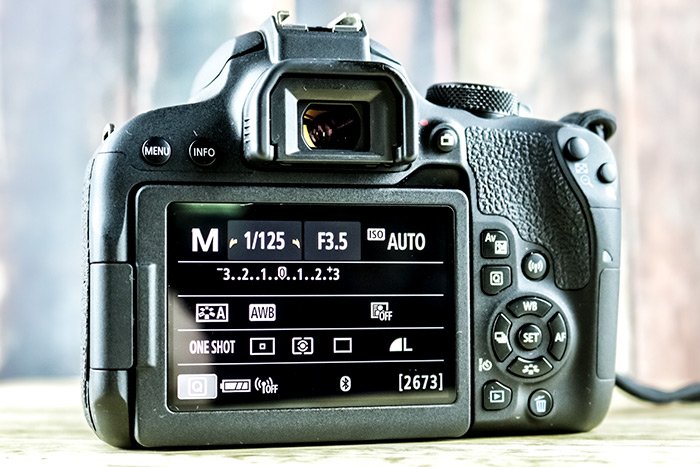
Accessing Quick Control mode is easy. Since the T7i has touch screen, all I would need to do is touch the small Q button that sits at the lower left corner of the rear LCD screen. If I were on an older model camera that didn’t have touch screen, such as the T2i, T3i, T4i and so on, I would have to push the physical Q button that sits just to the right of the rear screen.
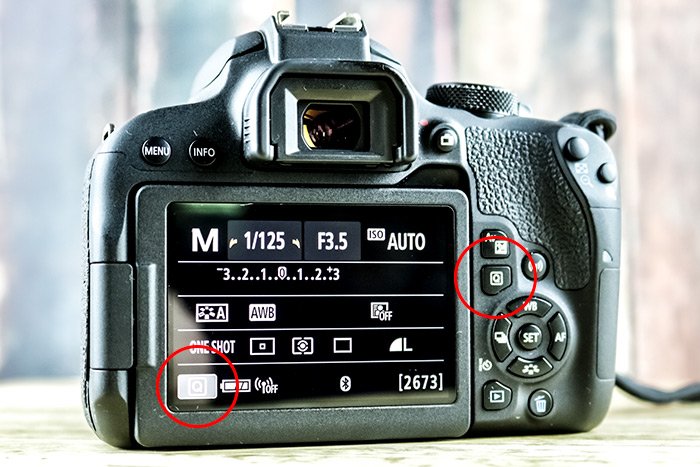
Once I push one of those buttons, I’ll see a slight change occur. Any options that are able to be altered will be surrounded by light gray boxes. Here, take a look. Notice the boxes around the various settings.
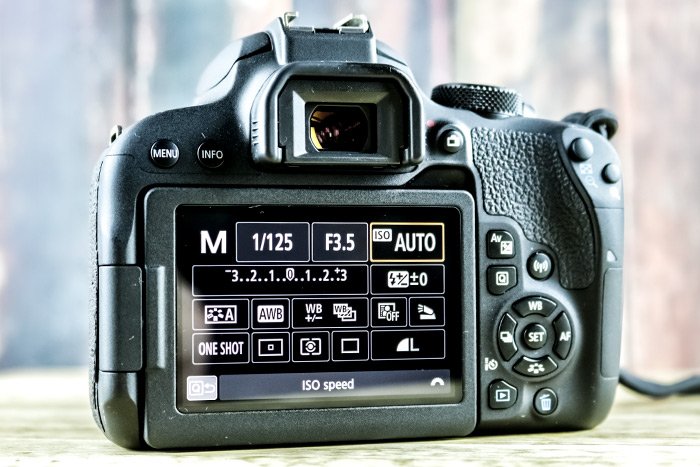
Remember, which settings you’ll have the ability to change depend on which mode the camera is currently in. Also, if you’ll notice, the functions that are able to be set are shown by popularity. Going from left to right, they’re listed in order of how frequently a photographer might reach for those settings.
If you don’t have touch screen, you’ll need to navigate to the area you’d like to adjust by pressing the arrow buttons on the back of the camera. When you land on what you’re interested in, you can press the Set button to enter the settings area for that particular feature. Then, to adjust the setting, you would use the dial at the top of the camera to choose the new value and finally, you’d press the Set button to apply the change. After being applied, the camera should return to the Quick Control screen on its own. If you would like to exit this screen or any active settings screen at any time, you could always press the Menu button that’s above the rear LCD screen on the back of the camera.
An important shortcut to consider is one that cuts out the middle man. If you were to highlight any of the available options on the Quick Control screen and simply roll the dial that’s on the top of the camera, you could change that particular value without ever accessing its own screen. Keep this in mind when you’re in the field because it’s the fastest option available.
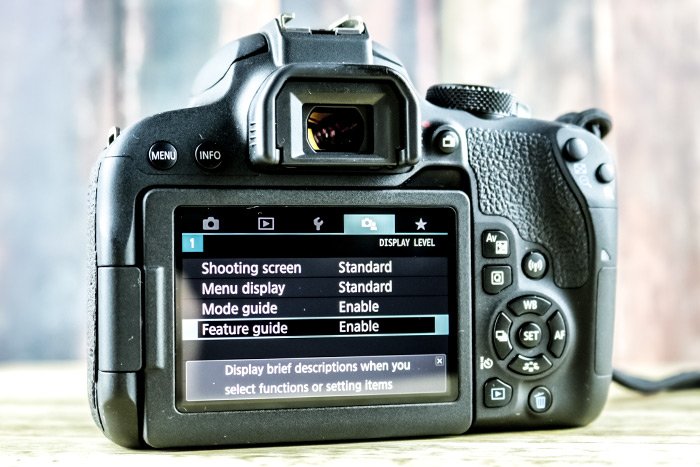
Once you click on it, you can use the up and down arrows to change the value to Disable. Then, press the Set button again and finally, press the Menu button to exit the menu area.
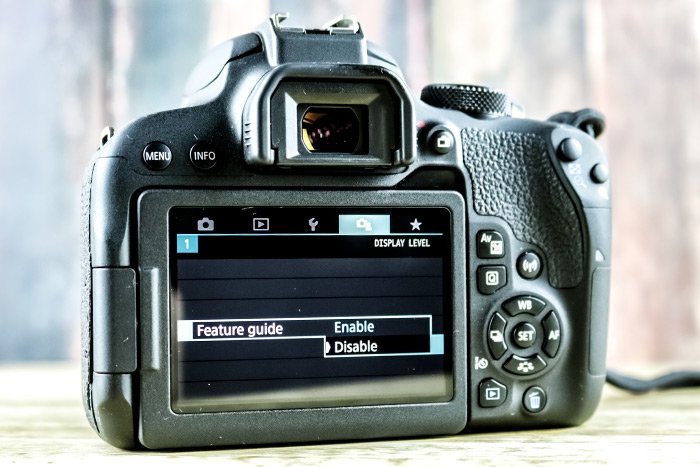
PS – This post refers to almost all Canon Rebel cameras, including the T2i, T3i, T4i, T5i, T6i and the newest T7i.
In today’s post, I’d like to introduce you to something called Quick Control that’s available on many Canon DSLR cameras. In its most basic sense, Quick Control is a mode that you can enter to change many of the settings on the camera. While there are other, more spread out, methods for accomplishing some of the same types of things, the Quick Control screen has so many options available in one place. And changing the available settings is a snap. All it takes is a push of one button and a push or a roll of another. This area is so important to be aware of for both new photographers as well as more advanced ones because it can definitely help getting things done much more quickly and efficiently.
How to Access Quick Control
For this post, I’ve decided to use my very own Canon T7i. This is the latest iteration of the Rebel line and I really do enjoy shooting with this camera in particular. It’s all about quality and ease of use.Okay, I’ve gone ahead and put the camera into Manual mode (M) so you can see almost everything that’s available on the Quick Control screen. Please be aware that you’ll have control over different functions while you’re in different shooting modes. Some functions will be available while others will be blocked out. For example, while in Manual mode, you’ll likely have the ability to change almost any setting, such as shutter speed, aperture, ISO, exposure compensation and so much more. While in Program mode (P) though, shutter speed and aperture are blocked out and are unable to be altered. And when you get to the even more automated modes, such as Creative Auto, Portrait, Landscape and so on, even more restrictions will be in place. Personally, I tend to forget which mode I’m in and I sit and wonder why I can’t change something. I do this all the time.

Accessing Quick Control mode is easy. Since the T7i has touch screen, all I would need to do is touch the small Q button that sits at the lower left corner of the rear LCD screen. If I were on an older model camera that didn’t have touch screen, such as the T2i, T3i, T4i and so on, I would have to push the physical Q button that sits just to the right of the rear screen.

Once I push one of those buttons, I’ll see a slight change occur. Any options that are able to be altered will be surrounded by light gray boxes. Here, take a look. Notice the boxes around the various settings.

Remember, which settings you’ll have the ability to change depend on which mode the camera is currently in. Also, if you’ll notice, the functions that are able to be set are shown by popularity. Going from left to right, they’re listed in order of how frequently a photographer might reach for those settings.
How to Change a Setting
Now, the big question is how to actually change a setting. On a touch screen camera, simply touch the setting you’d like to adjust. After that, touch the new value and then when you’re finished, touch the curved return arrow that’s at the bottom right corner of the screen. This will change the settings and then bring you back to the Quick Control screen.If you don’t have touch screen, you’ll need to navigate to the area you’d like to adjust by pressing the arrow buttons on the back of the camera. When you land on what you’re interested in, you can press the Set button to enter the settings area for that particular feature. Then, to adjust the setting, you would use the dial at the top of the camera to choose the new value and finally, you’d press the Set button to apply the change. After being applied, the camera should return to the Quick Control screen on its own. If you would like to exit this screen or any active settings screen at any time, you could always press the Menu button that’s above the rear LCD screen on the back of the camera.
An important shortcut to consider is one that cuts out the middle man. If you were to highlight any of the available options on the Quick Control screen and simply roll the dial that’s on the top of the camera, you could change that particular value without ever accessing its own screen. Keep this in mind when you’re in the field because it’s the fastest option available.
How to Disable Feature Guide
After using your camera for about a half hour, you’ll notice some rather annoying messages that continuously appear whenever you access many of the different areas of the camera. You can see one of these message in a gray box in the photo below. To turn these tips and guides off, head into the menu area by pressing the Menu button that sits above the rear screen. Then, once in that area, use the left and right arrow buttons to scroll back and forth until you see an option called Feature Guide. I can’t tell you where this option would fall because Canon keeps changing its location. On the T3i, it’s listed under one of the Tools headings, but on the T7i, it’s listed under the Display Level heading. Wherever it is, scroll to that option and then press the Set button.
Once you click on it, you can use the up and down arrows to change the value to Disable. Then, press the Set button again and finally, press the Menu button to exit the menu area.

PS – This post refers to almost all Canon Rebel cameras, including the T2i, T3i, T4i, T5i, T6i and the newest T7i.
